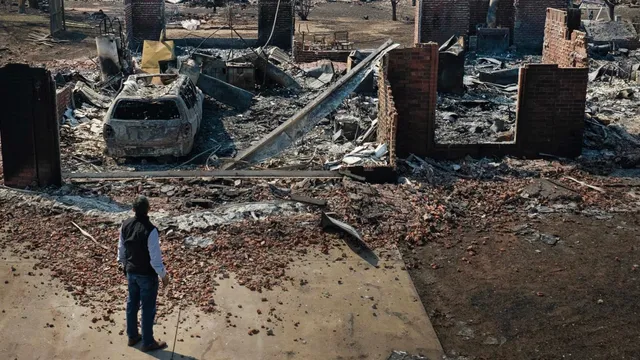
Wildfires devastate Oklahoma, claiming four lives
2025-03-18 13:23- Wildfires ravaged Oklahoma, damaging or destroying over 400 homes across the state.
- At least four lives were lost due to the fires and related incidents, with hundreds of injuries reported.
- The community is now focused on recovery and rebuilding as fire risks continue to persist.
Express your sentiment!
Insights
In Oklahoma, a series of devastating wildfires swept across the state during a severe weather outbreak, leading to numerous destruction of homes and loss of life. The fires, fueled by high winds, dry conditions, and unusually warm temperatures, began on Friday, with reports indicating that over 400 homes were either damaged or completely destroyed. Oklahoma's Department of Emergency Management reported more than 130 wildfires across 44 counties, with tragic results including the deaths of four individuals. Among those fatalities was a private citizen involved in a vehicle incident caused by extremely poor visibility due to dust and smoke. High winds were identified as a significant factor exacerbating the wildfire situation, as Oklahoma’s Forestry Services noted that gusts reached dangerous levels, making firefighting efforts exceedingly challenging. Several residents, including the governor, Kevin Stitt, faced destruction, with his own farmhouse reported as totally lost. Reports indicated that many families struggled to salvage belongings as they returned to burned properties, showcasing the community's spirit amidst tragedy. Local residents expressed a mix of sorrow and resilience, with many rallying together to help those in need. As Oklahoma faced continued fire threats into the following week, officials issued warnings about potentially more destructive fires; forecasters suggested that a recipe of high winds, low humidity, and dry vegetation set the stage for further fire danger. Predictive models highlighted an extensive critical fire risk area spanning several states, including Texas and New Mexico, leading experts to alert residents about the increasing risks. Finally, amid ongoing assessments and recovery efforts, state officials urged for vigilance regarding fire weather conditions, acknowledging the unpredictability of wildfires. They emphasized their commitment to provide support for those affected and underscored the collective need for preparedness against the continuing fire threat, reflecting on the importance of safety amidst ongoing natural challenges.
Contexts
Oklahoma has experienced numerous wildfires in recent years, stemming from a combination of natural and human-induced causes. The geography and climate of the state create conditions ripe for wildfires, particularly during periods of prolonged drought. With factors such as drought leading to dry vegetation, high temperatures, and strong winds, the risk of wildfires escalates. Additionally, human activities, including agricultural practices, land management, and recreational activities, often contribute to the ignition of fires. Understanding these causes is essential for formulating effective prevention and response strategies to mitigate future wildfire risks in the region. Statistical analysis reveals that wildfires in Oklahoma often peak during specific months, when weather conditions are most conducive to fire spread. Data collected over the past several years show that the majority of wildfires occur in late spring and summer, particularly between April and July. This data aids in allocating resources for firefighting efforts and improving public awareness campaigns. Furthermore, the financial impact of wildfires can be severe, affecting property value, agricultural output, and local economies. The costs associated with firefighting and recovery efforts can strain state resources and impact community resilience. In response to the growing threat of wildfires, Oklahoma has implemented various management strategies aimed at reducing the risk and impact of such events. These strategies include prescribed burns, firebreaks, and community education programs. Prescribed burning allows for the controlled elimination of excess vegetation, thus decreasing the fuel available for unplanned fires. Firebreaks are strategic gaps in vegetation that can slow the spread of wildfires. Additionally, public education initiatives are essential in equipping residents with knowledge on fire safety and prevention measures. As Oklahoma continues to adapt to changing climate conditions and increased wildfire frequency, further research and development of innovative firefighting techniques and community preparedness plans remain crucial. Collaborative efforts among government agencies, non-profit organizations, and local communities will enhance overall wildfire management. Utilizing advanced technology, such as satellite imagery and data analytics, can also play a pivotal role in early detection and response to wildfires, ultimately helping to safeguard lives and property.